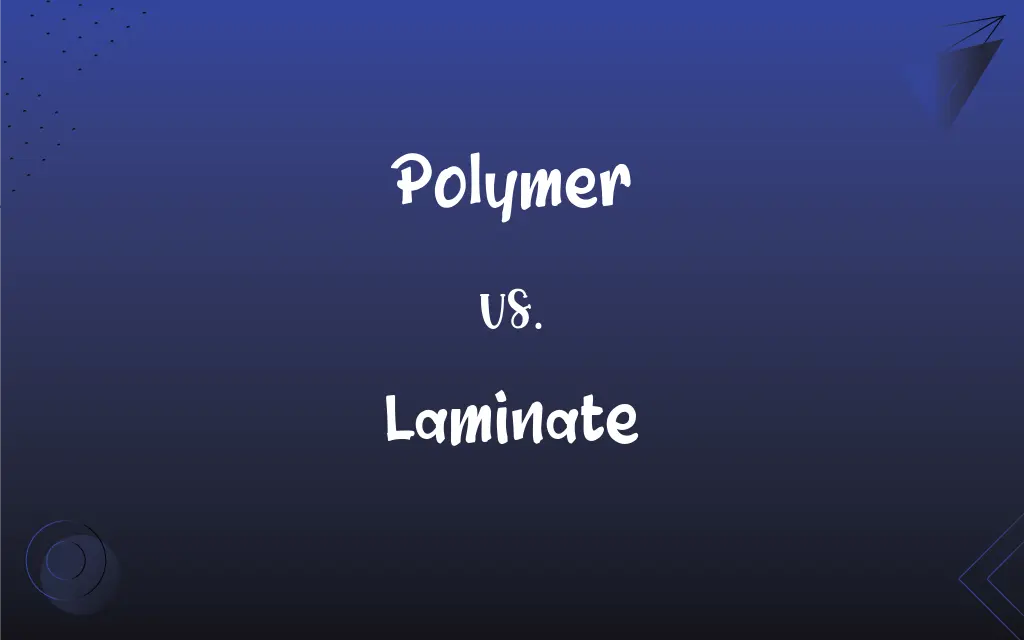Polymer vs. Laminate: What's the Difference?
Edited by Aimie Carlson || By Janet White || Updated on February 5, 2024
Polymers are large molecules made from many repeated subunits, while laminates are materials made by bonding two or more layers together.

Key Differences
Polymers are substances whose structures consist of large molecules formed by chemically bonding together many smaller units called monomers. These materials have diverse properties and uses, ranging from plastics and rubbers to natural biopolymers like DNA and proteins. Laminates, on the other hand, are composite materials created by assembling layers of different substances to achieve desired mechanical, aesthetic, or protective properties. The process of lamination enhances the strength, durability, and functionality of the base materials.
The distinction between polymers and laminates lies in their composition and formation. Polymers are defined by their molecular structure, which can be engineered to exhibit a wide range of physical characteristics. They can be flexible, rigid, transparent, or durable based on the nature of their monomers and the way they are synthesized. Laminates are not defined by their molecular structure but by their physical structure of layered materials. These can include layers of polymers, paper, metal, or wood, each contributing its qualities to the final product.
In terms of application, polymers are ubiquitous in modern life, found in everything from clothing and packaging to medical devices and electronics. Their versatility comes from the ability to tailor their molecular structure during synthesis. Laminates are used in applications requiring materials that are strong, lightweight, or resistant to moisture and wear. Examples include countertops, flooring, and outdoor signs, where the laminate provides a protective surface that is resistant to damage or wear.
The manufacturing processes for polymers and laminates also differ significantly. Polymerization involves chemical reactions that link monomers into long chains or networks. This process can be controlled to produce polymers of specific lengths, configurations, and properties. Lamination requires physical processes to bond layers together, using heat, pressure, or adhesives. The choice of materials and bonding methods affects the laminate's characteristics, such as its resistance to heat, chemicals, and physical stress.
Both polymers and laminates are crucial in various industrial and consumer applications, their differences are fundamental to their nature and uses. Polymers are notable for their chemical composition and versatility, while laminates are valued for their ability to combine the best features of different materials into a single product. These distinctions are essential for choosing the right material for a specific application, whether it's for durability, flexibility, or environmental resistance.
ADVERTISEMENT
Comparison Chart
Definition
Large molecules made from repeated subunits.
Materials made by bonding two or more layers.
Composition
Consists of monomers chemically bonded.
Consists of multiple layers of various materials.
Properties
Properties vary widely depending on the monomers.
Properties depend on the combination of layers.
Applications
Used in plastics, rubber, fibers, and biopolymers.
Used in flooring, countertops, and protective surfaces.
Manufacturing Process
Involves chemical synthesis of monomers.
Involves physical bonding of layers with heat or adhesive.
ADVERTISEMENT
Functionality
Tailored for specific chemical and physical properties.
Designed to enhance strength, durability, or appearance.
Polymer and Laminate Definitions
Polymer
Substance formed by polymerization.
The polymerization process creates polymers like nylon for textiles.
Laminate
Material created by bonding layers together.
The kitchen countertop is made from a durable laminate.
Polymer
Material with properties dependent on its structure.
Silicone polymers are valued for their flexibility and heat resistance.
Laminate
Process of creating multi-layered materials.
Laminating the wood veneers increases the strength of the panel.
Polymer
Basis for plastics and rubbers.
Polymers are the foundational materials for all plastic bottles.
Laminate
A product with a protective or decorative layer.
Laminated flooring is resistant to scratches and moisture.
Polymer
Natural or synthetic macromolecules.
DNA is a natural polymer essential for genetic information storage.
Laminate
Composite material used in furniture.
The shelves are constructed from a lightweight, strong laminate.
Polymer
Large molecule made from many similar units.
Polyethylene, a common polymer, is used extensively in packaging.
Laminate
Surface treatment for enhancing durability.
The documents were laminated to protect them from wear and tear.
Polymer
Any of numerous natural and synthetic compounds of usually high molecular weight consisting of up to millions of repeated linked units, each a relatively light and simple molecule.
Laminate
To cover with a thin sheet of material, as for preservation.
Polymer
(organic chemistry) A long or larger molecule consisting of a chain or network of many repeating units, formed by chemically bonding together many identical or similar small molecules called monomers. A polymer is formed by polymerization, the joining of many monomer molecules.
Laminate
To beat or compress (metal) into a thin plate or sheet.
Polymer
A material consisting of such polymer molecules.
Laminate
To divide into thin layers.
Polymer
Any one of two or more substances related to each other by polymerism; specifically, a substance produced from another substance by chemical polymerization.
Polymer
A naturally occurring or synthetic compound consisting of large molecules made up of a linked series of repeated simple monomers
FAQs
Can laminates contain polymers?
Yes, laminates can contain polymers as one of their layers.
What is the key difference between polymers and laminates?
The key difference is that polymers are single substances, while laminates are composed of multiple layers.
What is a polymer?
A polymer is a large molecule composed of repeated subunits called monomers.
What advantages do laminates offer?
Laminates offer durability, resistance to wear, and aesthetic appeal.
Are all plastics polymers?
Yes, all plastics are polymers, but not all polymers are plastics.
What is laminate?
Laminate is a material made by bonding two or more layers of material together.
Are polymers only synthetic?
No, polymers can be both synthetic and natural.
How are polymers formed?
Polymers are formed through chemical reactions that link monomers together.
Are laminates waterproof?
Some laminates are designed to be waterproof, depending on their materials and construction.
How do you choose between polymer and laminate for a project?
Choice depends on the specific properties and functionalities required, such as durability, appearance, and environmental resistance.
Can polymers be biodegradable?
Yes, some polymers are designed to be biodegradable.
What makes laminates resistant to damage?
Laminates' resistance to damage comes from their layered structure and the properties of the materials used.
What maintenance does laminate require?
Laminate maintenance typically involves regular cleaning and avoiding excessive moisture.
How are polymers categorized?
Polymers are categorized based on their origin (natural or synthetic) and their physical properties (thermoplastic or thermoset).
What are common uses of laminates?
Laminates are commonly used in flooring, countertops, and furniture.
How do the properties of polymers vary?
Polymer properties vary widely based on their monomeric composition and structure.
Are there environmentally friendly polymers and laminates?
Yes, there are eco-friendly options for both polymers and laminates, focusing on sustainable materials and processes.
What is the process of making laminate called?
The process of making laminate is called lamination.
What role do polymers play in modern materials?
Polymers are crucial for a wide range of modern materials, including flexible, durable, and lightweight products.
Can laminates be recycled?
Recycling laminates can be challenging due to their multi-layered composition.
About Author
Written by
Janet WhiteJanet White has been an esteemed writer and blogger for Difference Wiki. Holding a Master's degree in Science and Medical Journalism from the prestigious Boston University, she has consistently demonstrated her expertise and passion for her field. When she's not immersed in her work, Janet relishes her time exercising, delving into a good book, and cherishing moments with friends and family.
Edited by
Aimie CarlsonAimie Carlson, holding a master's degree in English literature, is a fervent English language enthusiast. She lends her writing talents to Difference Wiki, a prominent website that specializes in comparisons, offering readers insightful analyses that both captivate and inform.































































